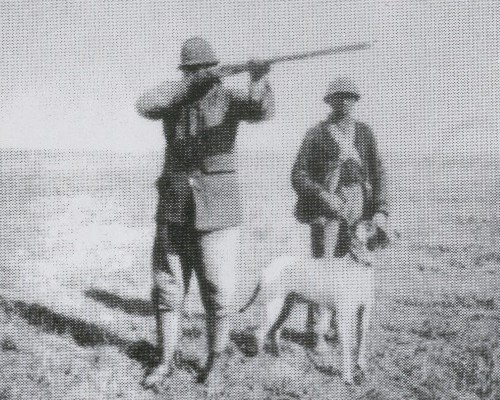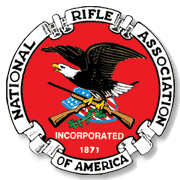|
J. J. Pringle
By Skip Hutchison

Pringle, Henry, and one of the pointers
used to help find dead birds
It is safe to say that most people do not know who John Julius Pringle was. Most hunters don't, even if they are avid bird or snipe hunters. However, if a discussion of baseball didn't mention Babe Ruth or one on Rock-n-Roll omitted Elvis or the Beatles something would be missing. In the world of snipe shooting J.J. Pringle is every bit as big as the aforementioned legends. The purpose of this article is to honor that man.
Pringle was born September 2, 1824, in Charleston, South Carolina. He came from a prominent family and was privileged to be able to attend school in England. After returning to the states his college days were spent at the Unites States Naval Academy at Annapolis, Maryland. He served in the U.S. Navy as a midshipman during the war with Mexico but for reasons I am unaware of did not fight in the war between the states. I don't know if the reason was age or indifference, but he spent those years in Europe. At the start of the war he would have been thirty-seven years old. I offer the preceeding information strictly for biographical purposes. It is the two decades following the war that bears noting from a sporting perspective.
Several Louisiana plantations were the location where Pringle did his snipe shooting, and shoot them he did. During the two decades he was keeping his shooting record he traveled back and forth between the states and England. Had he not been as actively involved in business his shooting numbers would no doubt be even more impressive than they already are. He had the means to afford guns by top London makers Grant, Lang, and Purdey. For the first half of his shooting campaign he shot nothing but cylinder choked guns, but when he got his Purdey with "choke" in 1877 he was truly impressed. Not only was he fortunate to be able to hunt some of the best grounds, he was doing so while major developments were going on in gunmaking. It was in 1882 that he acquired his first hammerless gun. At that point he was shooting nothing but Purdeys. A couple of distances are mentioned in his book, Twenty Years' Snipe Shooting, that if accurate, would still be impressive with the choke and load advancements we have today.
The season totals for birds shot by Pringle don't seem to follow any particular pattern. Two factors that were unquestionably the biggest contributors were number of days spent afield and water levels. He mentions abnormally dry and wet seasons specifically when summarizing some of his seasons. His numbers of days afield for any one season are not as high as most would expect. I don't think he gunned more than fifteen days in any month and most months he didn't shoot over half that many days. Some months he recorded as few as three, two, or even no days of shooting. It was the days he went out that he made the most of, including one where he spent six hours shooting and averaged just over one bird per minute for the entire time he was out. Do the math. At the end of his shooting career he was aware that bird numbers had diminished. That was to be attributed to habitat loss and overshooting both recreationally and for the market. In those days the mirgatory birds got shot hard on their nesting grounds as well as their wintering grounds. On October 30, 1901 John Julius Pringle passed away in Biarritz, France.
His days afield resulted in a total of 78,602 snipe killed, with 69,087 of them coming in the twenty years that are detailed in his book. The 9,515 that weren't killed within that timeframe are more than what 99% of all dedicated snipe shooters today will bag in their lifetime. Pringle's total was an astronomical number of birds and I don't believe that any other snipe hunter can even be mentioned in the same breath. Most people think of Lord Ripon as being at the head of the pack when it comes to wingshooting, and they might be correct if the discussion was about other birds. By comparison however, Ripon's lifetime total on snipe was around 1500 birds while Pringle picked up 1529 total on just his best five days of shooting. That doesn't make Pringle the best wingshooter nor does it make him the best hunter. Having access to the proper land and the drive to accomplish such a feat is why he stands head and shoulders above the rest when it comes to snipe shooting. He was in the right place at the right time and had the motivation required. I don't feel it is necessary to berate him and other shooters of large numbers of birds from the past. As long as game was recovered and eaten, as was always the case when Pringle shot, his shooting falls within the parameters of proper sportsmanship when kept in context of the era. Still, many show a disdain toward Pringle and other high volume shooters and that can usually be chalked up to nothing more than envy. I will say unabashedly that there is nothing I would enjoy more than to have been able to shoot snipe under the same conditions Pringle enjoyed. Could a person kill that many snipe today? No they couldn't, even if it was legal. The habitat has been depleted on both the nesting and the wintering grounds. The only way you can enjoy that type of snipe shooting today is by reliving the hunts through the game register of J.J. Pringle. I for one am thankful for it.

God Bless America!

We proudly support the NRA
Copyright 2001-2025 The Snipe Hunter
|


